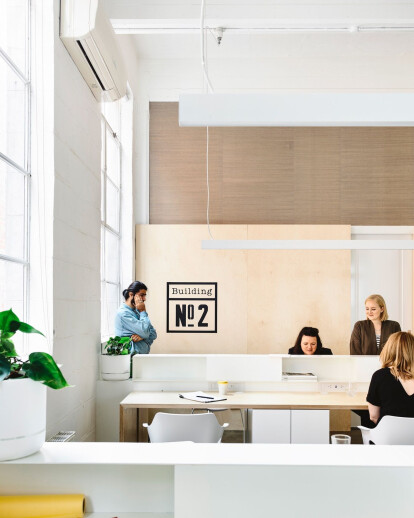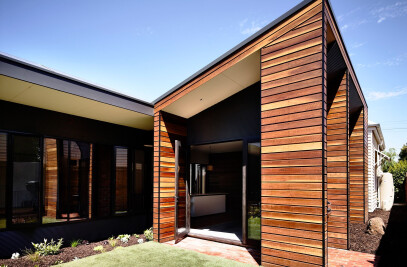1. Planning and repurposing a voluminous two storey mid-century industrial building that was once home to CSIRO’s printing library and converting the series of spaces mindful of the building’s original context into a co-working studio and resourceful operating venue for professionals.
2. A flexible brief recognised the quality of Building 2’s internal scale and how its highly robust structure could inform a series of interventions within. The qualities of the existing space include 4.5m floor to ceiling heights over each level, off form concrete roof, soffits and polished floors, original steel framed windows with an abundance of north facing natural light.Conceptually, we sought to work with the original space, which in its most recent history had been occupied by an interior designer. Having workshopped the requirements for the co-working studio thoroughly, we set out to implement via a minimal spatial planning process. At the upper level – a dedicated desk area for 12, two private offices each offering something different, a generous meeting room, break out space with mini kitchen and private bathroom.At ground level – a flexi desk area with two further private offices and open plan full kitchen with access to a courtyard, with full bathroom/laundry/end of trip facilities.The interventions were surfaced using Australian birch plywood, complementing the white painted concrete surfaces.Smaller details included updating the balustrade to meet current standards resulted in a sophisticated solution retaining the original with a white powder-coated aluminium sheet installed alongside.
3. The design of the dedicated desks was a project in itself. Testing the prospective needs of the occupier. Defining desk size required the creation of an appealing, personalised work area for members. This included personalised desk mounted gpo’s and usb capability, a lockable underdesk cabinet with drawer and ventilated cupboard suitable for a PC tower, laptop. A personalised white powdercoated aluminium shelf located above each desk was intended to provide a sense of privacy across each desk and a further opportunity for personalising each desk. Assembling the design for 12 workspaces, we firstly considered the personalised requirement as a key principle. The elemental assembly of the units characterised by long strips of Australian re-forested birch plywood was a consideration that drove the aim to both recognise the structural nature of the desks within a structurally informed space but also highlighted a sense of personalisation for each desk.
4. Preliminary research: At the outset of the project, we obtained, through a Freedom-Of-Information process, material from the CSIRO about the original building,built in the 1960s. It was discovered the building was one of three on the site and known as Building2. The correspondence was characterised by formality – letters with extensive references, date stamps etc. This informed the branding for a co-working space that resonates with the building’s history. The current business logo, based on a stamp itself, is plastered in, around and high up the building’s exterior and the CSIRO’s ‘blue’ colour was engaged as a reference throughout.
Special application – Interior design impact
1. The existing premises at what we now refer to as ‘Building No. 2’ were acquired mid-way through 2017 by the practice director and his partner. The practice itself is located only 300m away.
Pre-purchase due diligence uncovered a significantly capable existing building-structure able to manage additional future height with relative simplicity, so the future capacity to add greater floor-area and value partly drove the ensuing strategy.
The strategic investment options for the building, with existing net leasable floor-area of 220sq.m over two levels included:
a. Offer the premises with little/no improvements onto the commercial rental market
b. Consider relocating the practice to the premises
c. Find a way to get partial use of the space, yet encourage means for it to be income producing.
The primary financial goal from the outset was to manufacture a result that provided a financial return sufficient to cover costs and pay down the loans for the new building. If we combined that approach with some ability to use part of the space, then we considered a good sense of financial and enjoyment value could exist.
This led us to Option3 from the list above. So, during a relatively short settlement-period we workshopped possible options in conjunction with property specialists& trusted colleagues.
We rapidly formulated the view that the space, in its current format and with relatively minor works, could be transformed into a varying range of workspaces that could support the rapid population explosion of Collingwood and surrounds.
Under the banner of ‘co-working’ (without the ping pong& free beer) we researched and established that an intimate-scale range of considered workspaces that include private offices, flexible/dedicated desks with end of trip facilities, meeting room, high speed internet, bike parking, outdoor space and the like could be well received in the market.
2. Evidence for the impact:
The criteria employed (which include the tangible principles behind the business case) to develop the approach for the project included:
• The quality of the existing space is significantly appealing for its robust, mid-century industrial character
• High-ceilings (4.5m), abundant natural light and warehouse feel are all characteristics that property agents continue to reiterate are key factors attract all kinds of commercial operations to seek out quality spaces which positively represent their brands and businesses in an evolving precinct that is rich in post-industrial opportunity
• A perception that the workplace in general is undergoing a major shift from large, corporate machines to smaller, independent commercial operations
• The notion that people want a quality environment to integrate and help promote their brand. Whilst many are choosing flexible working conditions which includes work from home, there is a need to ‘get out of the house’ so to speak. The demand for flexible desk arrangements with quality services appeals and we are seeing that regularly.
• Younger professionals are commonly choosing to start their own businesses earlier, staying small and cost effective as opposed to joining a broader workforce machine. They need a place to operate and are prepared to pay for quality
• While there are two car-spaces and a carshare space nearby, there is a strong notion that a locally residing workforce will likely walk/cycle to work
The fit-out works were carried out and completed over a four-month period concurrently with the business model and establishment of brand, website and preliminary marketing exercises.
The business model sought to embrace automation (keyless entry/online payments etc) to minimise the need for excessive on-site management.
Ongoing sustainability initiatives, such as insulating the concrete roof from above and the ultimate vision of disconnecting the grid are set to take place as confidence in the business grows.
Three months in, Building No. 2 hosts a small but growing number of diverse professionals. Our design practice uses the meeting room to host team and project meetings and the cultural integration between our business and the members is starting to flourish.
As we kick into a marketing campaign to get the message out, local advertising and of course word of mouth are increasing the visibility of Building No. 2 as a highly considered workspace.
Our goal is to have the place fully subscribed by the end of 2018 or earlier. Should the jury be interested, we welcome a visit to Building 2.

































